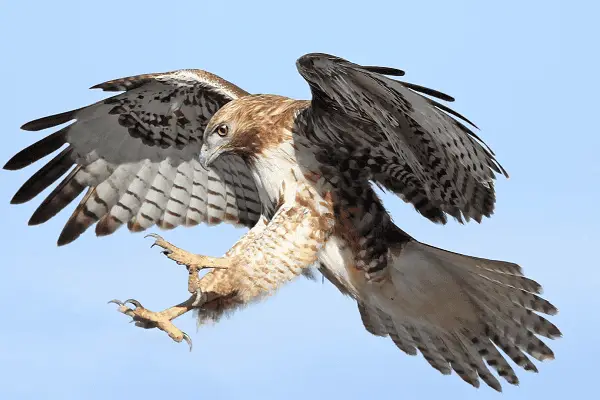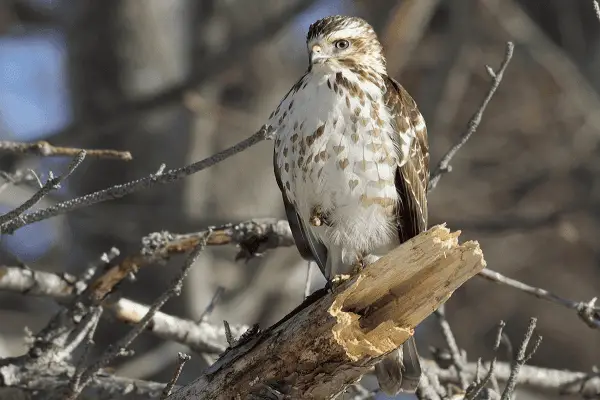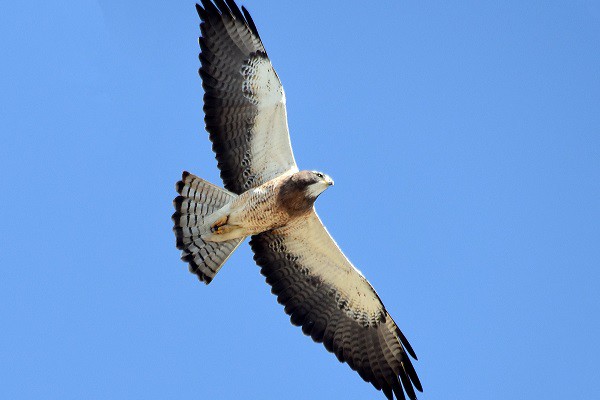When you think of Ohio, hawks might not be the first thing that comes to mind. But did you know that this state is home to a diverse range of hawk species? From the majestic red-tailed hawk to the elusive northern goshawk, Ohio offers a haven for these fascinating birds of prey.
In this article, we will explore the different species of hawks found in Ohio, providing photos and detailed information about each one. Get ready to discover the incredible variety of hawks that call Ohio their home and learn more about their unique characteristics and behaviors.
Here are the main points:
- Ohio is home to 9 species of hawks.
- The red-tailed hawk is one of the largest and most common hawk species found in Ohio.
- The sharp-shinned hawk is the smallest hawk species in Ohio.
- Ohio is a habitat for the northern goshawk, known for its larger size compared to other hawks in the state.
- The rough-legged hawk can be seen in Ohio during specific seasons.
1. Red-Tailed Hawk
The red-tailed hawk is a magnificent bird of prey commonly found in Ohio. With its distinctive red tail feathers, this large hawk species is a familiar sight in the state’s skies. Ohio is indeed the home of the red-tailed hawk, where it can be frequently observed soaring high and perching on tree branches.

The red-tailed hawk is known for its broad wingspan, which can reach up to 4 feet, allowing it to effortlessly glide through the air. Its plumage varies from dark brown to mottled patterns on its wings and back, while its belly is mostly white. Although their coloring may differ, both male and female red-tailed hawks share similar physical attributes.
These hawks have adapted to various habitats, including forests, prairies, and open spaces. They are remarkably versatile and can be found in both rural and urban areas across Ohio. Red-tailed hawks are skilled hunters that primarily feast on small mammals, such as mice, voles, rabbits, and squirrels. They are also known to scavenge for carrion, including roadkill.
The red-tailed hawk’s behavior involves perching on high vantage points, searching for prey from above, before swooping down with great speed and precision. They have keen eyesight and can spot potential prey from impressive distances. During courtship displays, red-tailed hawks showcase aerial acrobatics, including high soaring and spectacular dives.
To truly appreciate the significance of red-tailed hawks in Ohio, we must understand that they are one of the most common hawk species in the state. Their population remains stable, thanks to their adaptability and resilience in the face of various environmental conditions.
Let’s take a closer look at the red-tailed hawk’s characteristics:
| Characteristics | Description |
|---|---|
| Size | The red-tailed hawk is one of the largest hawks in Ohio, with a wingspan of up to 4 feet. |
| Habitat | They can be found in a range of habitats, including forests, fields, and urban areas across Ohio. |
| Food | Red-tailed hawks primarily prey on small mammals, such as mice, voles, rabbits, and squirrels. They also scavenge for carrion. |
| Behavior | They are skilled hunters that use high perches to spot prey from above, before swooping down with great speed and precision. |
| Population | The red-tailed hawk remains a common hawk species in Ohio, with a stable population. |
2. Red-Shouldered Hawk
The red-shouldered hawk (Buteo lineatus) is a common hawk species found in Ohio. It is known for its distinct red shoulders, which are visible when the bird is in flight. This medium-sized hawk has a length of about 17-24 inches and a wingspan of approximately 40-53 inches.

Red-shouldered hawks can be found in a variety of habitats, including deciduous forests, swamps, and wooded areas near water sources. They prefer to nest in tall trees, often near rivers or wetlands. These hawks are well adapted for perching and scanning the surroundings for prey.
In Ohio, the red-shouldered hawk is a year-round resident. It primarily feeds on small mammals, such as rodents and rabbits, as well as amphibians, reptiles, and small birds. Their hunting strategy involves perching on a high vantage point and swooping down to capture their prey.
This hawk species is known for its distinctive call, a high-pitched, far-carrying scream that is often used for territorial communication. Breeding season for red-shouldered hawks in Ohio typically begins in late winter or early spring, with the construction of elaborate nests made with sticks and lined with softer materials like leaves and moss.
3. Sharp-Shinned Hawk

The sharp-shinned hawk, a small but fiercely agile predator, is a common hawk species found in Ohio. Known for its stealth and precision, this hawk is the smallest of all hawk species found in the state. It is often mistaken for its close relative, the Cooper’s hawk, due to their similar appearance and hunting habits.
The sharp-shinned hawk is characterized by its compact size, measuring around 10-14 inches in length. Its short, rounded wings and long tail enable it to swiftly maneuver through dense forested areas and catch small birds and mammals in flight. With keen eyesight and remarkable speed, this hawk is a skilled hunter.
These Ohio hawks primarily rely on their stealth and agility to sneak up on their unsuspecting prey. They have been observed perching in the understory of wooded areas, patiently waiting for an opportunity to strike. Once spotted, the sharp-shinned hawk swiftly takes flight, deploying its remarkable aerial skills to pursue and capture its prey.
Hunting Behavior and Diet
The diet of a sharp-shinned hawk primarily consists of small birds, such as sparrows, finches, and warblers. They have also been known to feed on small mammals, including mice and voles. Their exceptional agility allows them to navigate through dense vegetation and catch their prey mid-air.
Sharp-shinned hawks are known for their sharp talons and beak, which they use to dispatch their catch quickly. After capturing their prey, they often pluck the feathers before consuming it.
Similarities to Cooper’s Hawk
Given their physical similarities, the sharp-shinned hawk is often confused with the Cooper’s hawk. Both species share traits such as long, narrow tails and rounded wings. However, the sharp-shinned hawk can be distinguished by its smaller size, with males being significantly smaller than females.
While the Cooper’s hawk also inhabits Ohio, it is larger than the sharp-shinned hawk. Despite the similarities, these two hawk species have distinctive hunting preferences. Sharp-shinned hawks tend to focus on capturing smaller songbirds, while Cooper’s hawks have a greater inclination towards pursuing medium-sized birds.
A Comparison of Sharp-Shinned Hawk and Cooper’s Hawk
| Sharp-Shinned Hawk | Cooper’s Hawk | |
|---|---|---|
| Size | Smaller | Larger |
| Wingspan | Around 19-24 inches | Around 28-36 inches |
| Prey Preference | Smaller birds, mammals | Medium-sized birds |
| Hunting Technique | Stealth and agility in dense vegetation | Aerial acrobatics |
4. Cooper’s Hawk

The Cooper’s Hawk is a fascinating hawk species that can be found in Ohio. Known for its agile flight and remarkable hunting ability, the Cooper’s Hawk is a common sight in the state’s forests and woodlands.
Physical Characteristics: The Cooper’s Hawk is a medium-sized hawk with a length of about 15-20 inches and a wingspan of 30-35 inches. It has a distinct dark cap on its head, a bluish-gray back, and reddish bars on its chest. Males are smaller than females.
Habitat Preferences: Cooper’s Hawks are adaptable and can be found in a variety of habitats, including suburban areas, parks, and forests. They prefer areas with dense vegetation, as it provides ample cover for their hunting activities.
Hunting Behavior: Cooper’s Hawks are known for their exceptional hunting skills. They primarily prey on birds, capturing them in mid-air with incredible precision and speed. Their long tail and short wings allow them to navigate through dense foliage while chasing their prey.
Despite their remarkable abilities, the Cooper’s Hawk is often confused with another hawk species, the Sharp-shinned Hawk. While they do share similar physical features, there are distinguishing characteristics that set them apart. The Cooper’s Hawk is larger in size, with a more rounded tail and a proportionally larger head. On the other hand, the Sharp-shinned Hawk is smaller, with a squared-off tail and a smaller head.
| Cooper’s Hawk | Sharp-shinned Hawk |
|---|---|
| Size: Medium | Size: Small |
| Tail: Rounded | Tail: Squared-off |
| Head: Larger | Head: Smaller |
It’s important to accurately identify these hawk species, as they have different behaviors and ecological roles. Observing these magnificent raptors in their natural habitat is a thrilling experience that highlights the diverse birdlife of Ohio.
5. Broad-Winged Hawk
The broad-winged hawk is a fascinating species of hawk that can be found in Ohio. Known for its unique nesting habits, migration patterns, and feeding preferences, the broad-winged hawk offers a distinct experience for birdwatchers and nature enthusiasts in the state.

Unlike other hawk species, the broad-winged hawk has a preference for nesting in dense forests, often choosing large deciduous trees as their breeding sites. These hawks are known for their cooperative breeding behavior, with multiple pairs often nesting in close proximity to one another.
When it comes to migration, the broad-winged hawk is a true spectacle. It is known for its tendency to migrate in large groups, forming what is commonly known as a “kettle” of hawks. During their migration, these hawks can be seen soaring in the sky in a circular pattern, offering a remarkable sight for birdwatchers.
In terms of feeding habits, the broad-winged hawk stands out from other hawk species. While many hawks primarily feed on small mammals and birds, the broad-winged hawk has a preference for eating large insects, such as grasshoppers, crickets, and dragonflies. This unique feeding behavior sets them apart from their hawk counterparts.
The broad-winged hawk is a remarkable bird that adds to the diversity of hawk species in Ohio. Its nesting habits, migration patterns, and feeding preferences make it a captivating species for both researchers and birdwatchers alike.
| Nesting Habits | Migration Patterns | Feeding Preferences |
|---|---|---|
| Nests in dense forests | Migrates in large groups (kettles) | Feeds on large insects |
| Chooses large deciduous trees as breeding sites | Offers a remarkable sight for birdwatchers | Preferably eats grasshoppers, crickets, and dragonflies |
| Cooperative breeding behavior | Soars in circular patterns during migration |
6. Northern Goshawk
The northern goshawk is one of the largest hawks found in Ohio. With its impressive size and striking appearance, this bird of prey is a sight to behold. Known as a buteo hawk, the northern goshawk is a powerful predator that can be found in various habitats throughout the state.

The northern goshawk is well-adapted to its environment, with a broad wingspan and sharp talons that make it an efficient hunter. This hawk primarily preys on smaller birds and mammals, using its agility and speed to pursue and capture its prey.
In Ohio, the northern goshawk can be found in forests and woodlands, where it builds its nests high in the trees. These nests, known as eyries, are large structures made of sticks and lined with softer materials. They provide a safe and secure breeding ground for the goshawk.
While the northern goshawk is not as commonly seen as some other hawk species in Ohio, birdwatchers and nature enthusiasts can still spot this majestic bird in certain areas of the state. Its impressive size and distinctive markings, including dark gray feathers on its back and a bold white stripe above its eyes, make it easily recognizable.
Habitat and Hunting Techniques
The northern goshawk prefers mature forests with a mix of coniferous and deciduous trees. These habitats provide ample cover for the bird to nest and hunt. The goshawk relies on its exceptional vision and stealthy approach to surprise its prey. It often hunts by perching on a high vantage point, patiently observing its surroundings before launching a swift and precise attack.
Unlike some other hawk species that rely primarily on soaring and gliding, the northern goshawk is a master of maneuvering through dense foliage and navigating intricate forest environments. Its short, broad wings allow it to swiftly navigate through obstacles, making it a formidable hunter in the forest canopy.
Presence in Ohio
The northern goshawk is a resident breeder in Ohio, meaning that it remains in the state year-round to breed and raise its young. While it may be less frequently seen than other hawk species, its presence in Ohio’s forests is a vital part of the state’s ecosystem.
As a top predator, the northern goshawk helps maintain balance in the local food chain by keeping populations of smaller birds and mammals in check. Its presence also serves as an indicator of a healthy and thriving forest ecosystem.
Overall, the northern goshawk is a remarkable and captivating hawk species found in Ohio. Its large size, impressive hunting techniques, and importance within the local ecosystem make it a significant part of the state’s avian biodiversity.
7. Rough-legged Hawk
The rough-legged hawk is a fascinating hawk species that can be found in Ohio. With its unique appearance, behavior, and habitat preferences, the rough-legged hawk stands out among the hawks in Ohio.

One of the defining characteristics of the rough-legged hawk is its feathered legs, which allow it to thrive in colder climates. This adaptation is particularly useful in Ohio, where the winters can be harsh. You can easily identify this majestic bird by its large size, broad wingspan, and distinctive markings.
During the winter months, the rough-legged hawk migrates to Ohio, making it a seasonal resident in the state. It prefers open fields and grasslands as its habitat, where it can spot its prey from above and soar gracefully in the sky. Ohio’s rural areas provide the perfect environment for the rough-legged hawk’s hunting and nesting needs.
As a large hawk species in Ohio, the rough-legged hawk plays a vital role in the ecosystem. It preys on small mammals such as voles, mice, and rabbits, helping to control their populations. This hawk species showcases impressive aerial hunting skills, often hovering in the air before diving down to catch its prey with precision.
The rough-legged hawk’s presence in Ohio during the winter months offers a unique opportunity for bird enthusiasts and nature lovers to spot and observe this magnificent bird in action. Whether you’re a seasoned birdwatcher or a casual observer, encountering a rough-legged hawk in Ohio is an experience to cherish.
8. Swainson’s Hawk
The Swainson’s Hawk is a majestic species of hawk that can be found in Ohio during specific times of the year. Known for its impressive migration patterns, this hawk species captivates bird enthusiasts and wildlife observers alike.

During the breeding season, Swainson’s Hawks can be seen nesting in the open grasslands and prairies of Ohio. Their large stick nests dot the landscape as they prepare for the arrival of their young. These hawks are known for their distinctive appearance, with a dark brown back and a light-colored chest.
Migrating from as far as Argentina, Swainson’s Hawks embark on an incredible journey, covering thousands of miles to reach their breeding grounds in Ohio. They arrive in the state during late spring and early summer, making Ohio an important stopover for these traveling raptors.
As Swainson’s Hawks soar through the Ohio skies, their graceful flight and keen hunting skills are a sight to behold. These hawks primarily feed on small mammals, such as mice and ground squirrels, as well as insects and reptiles.
